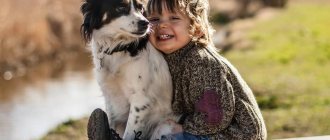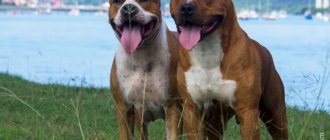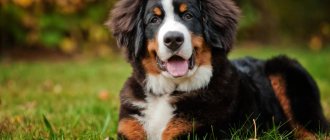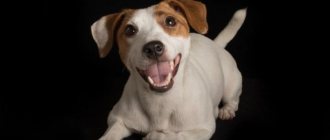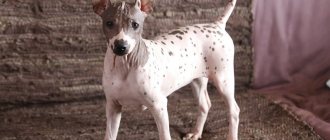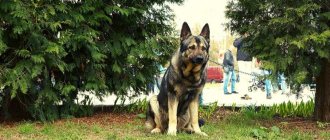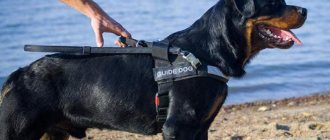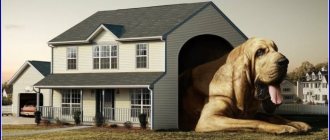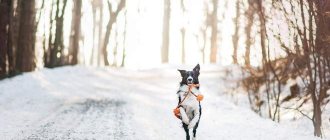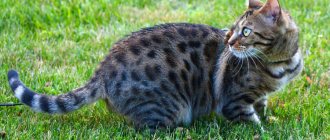The Asian continent boasts thousands of years of cultural history and is currently home to almost 60 percent of the world's population. It is not surprising that so many different breeds of dogs appeared there.
Although their initial domestication is still a matter of debate, recent research has established that ancient Southeast Asia is home to at least 15 of the world's most famous dog breeds . Now they have settled all over the world - they are also happily planted in Europe and America. Joinfo.com shares interesting features of popular pets.
Medium Gray Dog Breeds
Among the medium-sized dog breeds, we can find many with gray fur. Like large gray dogs, they may also have gray patterns instead of a solid color. Those that most often have gray fur:
American Staffordshire Terrier
Although they may look like large dogs, the American Staffordshire Terrier is actually only medium-sized compared to other breeds. This has been appreciated by various canine associations. According to the same organizations, all coat colors and patterns are allowed in the breed standard. This includes gray, blue-gray or gray-white dogs.
In many countries, this dog breed is considered potentially dangerous due to its physical characteristics. While every dog will require you to do your research, it is especially important to know what to expect from a Staffy. Despite this fact, the American Staffordshire Terrier is a very loving breed that can be good with children and is very playful. Bite suppression and socialization training is very important.
Staffordshire Bull Terrier
Another pit bull type dog is the Satfordshire Bull Terrier. They are smaller than the previous gray dog on our list. They can have different coat descriptions including red, brindle or solid. Gray-blue within the accepted color range, but may appear with white spots.
Like the previous gray dog, they are very playful and friendly, but need proper socialization and training...
American Pit Bull Terrier
It is also believed that the medium-sized American Pit Terrier can have any solid or colored pattern. Almost the only exception is the Merle pattern. They are also considered potentially dangerous in some countries. For this reason, if you are considering adopting gray dogs such as the American Pit Bull Terrier, you should check local laws and see if they require a license.
Muzzles should also be worn when walking with an American Pit Bull Terrier. Despite these precautions, they are very loving and sociable dogs. Positive reinforcement should always be used when training these dogs.
schnauzer
All types of Schnauzer dogs can have a grayish coat. However, whether giant, standard or miniature, simply pure black and so-called 'salt and pepper' coats are accepted by the FCI. The Schanuzer is an energetic dog that hates being left alone at home. If they are not given enough attention, they may develop separation anxiety. This may come in the form of constant barking or destruction of property.
Thai Ridgeback
Native to Thailand, the Thai Ridgeback is another of the most distinguished gray dogs. Their solid gray or blue-gray coats are among the few accepted colors in this breed. They are also characterized by wrinkles on their forehead and by being a well-proportioned dog.
His character is very active and energetic. They need plenty of exercise as well as physical and mental stimulation. Without this, they may develop behavior problems.
Cavalier King Charles Spaniel
These little dogs have a very long history. At one time, they lived in the houses of the aristocratic nobility and were used for bird hunting.
Cavalier King Charles Spaniels are small animals whose height does not exceed 33 cm and weighs no more than 8.2 kg. On the harmonious round head with a wide forehead and a smoothed occipital protuberance, there are huge expressive eyes and long ears covered with decorative hair. The strong, square body with a developed chest is completely covered with a soft, silky coat of two or three colors.
Large gray dog breed
There are several types of large and giant dog breeds that can have gray fur. Some are completely gray dogs, others may have white spots or spots. Here we give examples of large gray dogs with information about their care:
Weimaraner
The Weimaraner, known by its full Weimaraner title Vorstehhund in its native Germany, is perhaps the quintessential gray dog breed. This is because the only color of this breed accepted by standard dog breed associations is gray. However, there is room for different layers as they take on silver, navy or mousey gray shades. The strange curiosity of this gray dog breed is that its eyes are striking puppy fur that turns amber as it ages...
Weimaraners stand out because they are very active and energetic. This is why it is important to provide frequent walks and plenty of opportunities for daily exercise. If they lack physical and mental stimulation, they can become destructive. People with a sedentary lifestyle should not have a Weimaraner as a pet.
German dog
Although it is very common to see Great Danes with patterned or marbled markings, it is possible that they may display varying shades of gray. They may even have a completely gray coat. The Harlequin has a variety of colors, including white fur with gray spots.
Despite its appearance, the Great Dane is not one of the most active dog species. Although they will need adequate daily exercise, they can remain indoors for long periods of time as long as they have enough room to maneuver. However, this does not mean that they should spend too much time alone. If they are not socialized properly, they are prone to separation anxiety.
Siberian Husky
Another of the most popular gray dogs is the Siberian Laika. Her most popular coat pattern is a combination of white and gray. These colors can be of varying degrees of darkness. Another common feature of the Siberian Husky is heterochromia, that is, the presence of two eyes of different colors...
The Husky is a Nordic dog that was bred to withstand very cold temperatures. It is not suitable for very hot or tropical climates, although they can tolerate heat better than some Nordic breeds. He is also a very active dog who loves to play and stimulate his mind. Here's why mind games should be included in your gaming sessions...
Small gray dog breeds
Smaller gray dog breeds may be either completely gray or have only gray as part of their coat pattern. The most common small gray dog breeds are:
Italian Greyhound
The smallest greyhound dog, the Italian Greyhound, typically does not exceed 5 kg in weight and 38 cm in height at the withers. This is a smart, sweet, affectionate, calm and very sensitive dog. They are wonderful companions for those who can spend enough time with them, both indoors and outdoors. Common colors in this breed other than gray include black, white or tan.
Yorkshire Terrier
The most common color of the Yorkshire Terrier is a coat that is not entirely gray. While they have a beautiful metallic gray coloring on their body parts, the rest is a beautiful fiery color. However, you can see examples of Yorkies in blue or silver gray. They are especially known for their beautiful long hair that can be cut in a variety of styles...
poodle
Like the Schnauzer, the Poodle comes in several different types, which are primarily determined by its size. All types of poodles can show gray in their fur pattern, although it will be in several different shades. Poodles of all types tend to be very strong-willed, well-behaved, responsive to play, and can be incredibly loving. They are also noted as one of the smartest dog breeds in the world, so they need a lot of games to learn...
Chinese Crested Dog
Another type of small gray dog is the Chinese Crested Dog. Although they are not a solid color, this is not related to the coat pattern. This breed is unique in our list of gray dogs because its coat is actually white and its fur is gray. Since they have no hair on most of their body, these parts are visible and give them a gray tint. Hairy parts usually cover its head, tail and legs. These pieces of skin are what gives them their tufted appearance.
beagle
Elegant, stylish and proportionate, the Whippet is an energetic, loving and responsive dog breed. All colors and combinations are accepted except merle patterns. Although they may seem like a calm dog, they need plenty of exercise and should ideally be allowed to run freely in a large yard.
Other gray dog breeds
Of course, there are still many gray dog breeds. They can have a completely gray layer or a gray layer combined with white and other colors. More examples of gray dogs:
- Border Collie
- Neapolitan Mastiff
- Canary Mastiff
- Alaskan Malamute
- Irish Wolfhound
- Bedlington Terrier
- American bully
- Tibetan mastiff
- Czechoslovakian wolf
- Catalan Shepherd
- Giant Pyrenees
- Bearded Collie
- shorten
- Shih Tzu
Red Breton Griffon
An ancient hunting dog with a strong body and a large head. Representatives of this breed have a predominant orange color. All its varieties are considered the most preferable: from brick to wheat-golden. The presence of a light, uneven mark on the chest is relevant. There are small patches of black hair on the mask, in the area of the mustache, sideburns and beard. The mask of griffons can become almost invisible or simply more intensely red or red.
Read The best herding dogs - 20 breeds and their uses
Dalmatian
These are quite ancient dogs with an unclear history. According to one version, they appeared in Ancient Egypt and from there they came to Europe. According to another theory, their homeland is the Croatian province of Dalmatia, after which they got their name. They were brought to the territory of the USSR in the 80s of the 20th century and quickly gained popularity among local breeders. In 1991, on the initiative of S.V. Petrakov, a club for lovers of this breed was created.
Dalmatians are spotted dogs of medium size. Depending on the sex, the height of an adult is 54-62 cm with a weight of 24-32 kg. The elongated head with a straight bridge of the nose, strong jaws and a moderately pronounced nose has dark, round eyes and thin, hanging ears. A strong, proportionally built body with a flat back, a voluminous chest and a slightly sloping croup is covered with short, stiff white hair with evenly distributed, clearly defined spots of brown or black.
Dalmatians are cheerful, good-natured animals that are easy to train. They are very emotional, sensitive and touchy. These dogs need constant communication with people. Lack of attention turns them into closed, indifferent animals.
Basset Hound
These short-legged spotted dogs with long ears were bred in Europe in the middle of the 14th century. They were originally used for hunting small game. But today they have turned into good companions, adapted to life in urban conditions.
Bassets are medium-sized dogs, whose height reaches 33-38 cm and weighs 23-29 kg. The well-proportioned, folded head has dark, diamond-shaped eyes and long, drooping ears. The squat, short-legged body of a typical representative of this breed is covered with dense thick hair of different colors. The most common species are white with black or fawn markings.
Bassets are aristocratic, kind-hearted dogs with high intelligence and a well-developed sense of smell. They are endowed with a peaceful, affectionate disposition and a sonorous voice.
Rhodesian Ridgeback
Experts note several colors of this pet. The shade of the coat varies within several limits: from honey, wheat to bright burgundy. The Ridgeback is only black when it is a puppy. Gradually its color changes and becomes close to red. A dark mask on the face and ears is allowed. They have short, shiny fur that lies close to the body.
A characteristic feature of the breed is the “ridge” (from which the dog is named) on the back, formed by hair growing in the direction opposite to the rest of the dog’s coat. The dog's build is muscular, with a strong back and neck with a slightly curved loin. Long front legs allow it to rush quickly and push off the ground powerfully.
Shiba Inu
Another dog vaguely reminiscent of a fox: a strong, proportional body, a small head and an elongated muzzle with sparkling dark eyes. The most common is a rich red or bright red tone. According to the canine community, a rich color is considered preferable, but without turning into brick. A light red undertone with small patches of black hairs is possible. This color is also called sesame. This dog has a very thick, dense coat of equal length, with a highly developed undercoat.
Jack Russell Terrier
The breed is popular among breeders thanks to its debut in the film “The Mask” with Jim Carrey. And now it has not lost its popularity to this day. The generally accepted standard highlights the following features of appearance: a flat back, a straight, slightly elongated body, they have a strong, strong neck, and a medium-sized sternum. The dog's muzzle has developed muscles, the shape of the head is similar to a blunt wedge, with wide, non-protruding cheekbones.
One of the characteristic features that distinguishes this dog from others is its drooping ears, which are capable of rotating 60-80 degrees. As a rule, orange color can be of various tones.
The classic coat color characteristic of the Jack Russell is a combination of red spots and snow-white fur covering most of the body. The spots must be located on the ears, back or tail, and not on the abdomen. There are all varieties of red tones: from milky to dark amber. The animal's fur coat can be different: in addition to short, there is a medium-long one, forming a beard and eyebrows.
American Staffordshire Terrier
These representatives of the canine world are considered a “thunderstorm” to strangers; they have a massive front part with a large head, a wide muzzle and a powerful jaw. There is a slight stiffness in movements due to the elongated hind legs, the front legs are spaced quite widely.
Cynologists allow almost all shades of “red” - from bright red to cream. Spotted dogs often have a combination of white and orange tones. Moreover, white spots should cover no more than 20% of the body. The fur is distinguished by its unique shine and thickness. It is hard to the touch and fits tightly to the body. Pets of a brick or black-and-red hue are considered a waste.
Separation by purpose
Each dog has its own personality and build. Through selection, people were able to divide dogs according to specified qualities. For some breeds, speed is important, for opposite breeds, strength is important. Balanced and irritable representatives, brave and cowardly, are known. Each breed is defined by its appearance and character.
By purpose they are distinguished:
- Hunting dogs. Previously the main category of pets, they are distinguished by their innate search and hunting instincts. They obey people unquestioningly, respond well to training and undergo special training courses. Divided into subcategories:
- Hounds can track game by scent and begin chasing until the hunter appears.
- Greyhounds are hunters and are required to catch the animal on their own, without the use of a gun.
- Retrievers have a good sense of smell. The task is to find and present the game to the hunter.
- Spaniels, like retrievers, are engaged in retrieving game. They work better on birds in wetlands where there is a lot of bushes.
- Dachshunds are a breed bred for burrow hunting.
- Terriers are a large family of hunting dogs that specialize in burrowing game and are used to fight rodents.
- Cops are pets focused on game birds.
Regardless of size, representatives of the breeds are grouped into other breed classes. For example, there are known breeds that are ideal for hunting. In the forest their whole life, melancholic and slow, they instantly turn into super fast and dexterous miners.
Hunting dogs require constant movement. The instinct that forces you to pursue the victim to the end requires constant physical activity, training and forests. A city resident who gets such a dog is doing something akin to animal abuse. Try to choose animals that suit your living conditions.
- Non-hunting breeds. The rest are pets. Dividing the category is not easy. Dogs today move from category to category. Highlight:
- Fighting dogs – the main specialization is animal baiting and fighting.
- Poisoning plants specialize in large animals.
- Molossians - the breed is classified as a pickling breed, with Egyptian and Assyrian roots of origin;
- Bulldogs were bred to fight bulls, hence the name.
- Sled dogs are used to move cargo and people on bunks and sleds. This category includes huskies and huskies.
- Herding breeds. They are distinguished by their innate instinct to guard the livestock, the yard, and the owner. Capable of protecting herds from predators.
- Decorative breeds. A large group, mainly small dogs with beautiful appearance. They lived in the courts of nobles and kings and were pets.
Recently, hunting breeds have been dying out; hunting is not so popular. There are fewer and fewer fighting species declared dangerous for home keeping. Some disappear, others are simply relegated to the decorative group.
Dogs for service and protection
It is not recommended to confuse representatives of aggressive breeds and service breeds. Of course, fighting dogs are used to serve and detain criminals and protect borders. But more often specially bred breeds are used.
In addition to excellent performance characteristics, representatives of the species are hardy. Constant work required. It consists of either training or constant outdoor games. Service dogs are easier to train. They do not claim leadership in relations with the owner. The main character traits are considered to be hard work, obedience and high intelligence.
Unlike representatives of hunting breeds, animals are attracted to work. When dogs feel that they are needed, needed, their help in a difficult situation is simply necessary, dogs live fully. It happens that people get representatives of service breeds for individual protection. Here, owners should take into account that animal training is required. Pets are excellent rescuers and loyal friends for their owners. Desperate determination and courage force them to take blows just to protect their owner.
Guard dogs
Representatives of the group always differ in their peculiar behavior from other brothers. Their never-vanishing ancient instinct forces them to zealously protect their own territory from the encroachments of strangers; even while walking, the dog constantly studies areas and marks them. Guard dogs will not tolerate strangers on their territory, showing aggressiveness towards uninvited guests. Owners are required to pay a lot of attention to training and education.
Individuals must learn from childhood: only the owner is considered the main one, he is required to obey, but obey completely. When properly raised, animals behave quite normally. Ideal conditions for keeping dogs: country houses with large plots, where the dog has the right to run freely and guard the designated territory.
Moreover, representatives of guard breeds will not tolerate their brothers on their personal territory, although on walks they are able to walk and play together quite friendly.
